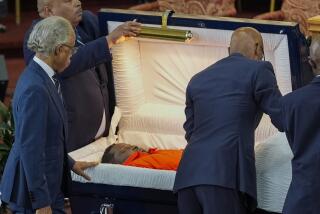Winnie Mandela Is Convicted in Kidnaping Case
- Share via
JOHANNESBURG, South Africa — A South African judge, describing Winnie Mandela as a “calm, composed, deliberate and unblushing liar,” found the black liberation leader guilty Monday on four kidnaping charges and four counts of accessory to assault after the fact.
Judge Michael S. Stegmann of the Rand Supreme Court in Johannesburg concluded that Mandela had ordered the abduction of four youths from a Soweto church house in 1988 and later helped cover up their beatings, which resulted in the death of a 14-year-old black youth.
“To imagine all of this took place without Mrs. Mandela as one of the moving spirits is like trying to imagine ‘Hamlet’ without the prince,” Stegmann said during a seven-hour reading of his verdict.
The judge ruled that prosecutors had failed to prove their contention that Mandela participated in the assaults, which occurred in a room behind her home, and he described her alibi--that she was en route to the Orange Free State--as “reasonably possibly true.”
However, Stegmann found her guilty of the lesser charge of “accessory after the fact” to the beatings. He rejected Mandela’s claim that she was never aware of the beatings, concluding that she had to have learned about them when she returned home two days later. He said she then helped “the principal offenders” hide their crime by refusing repeated requests from community leaders to free the survivors.
Mandela, 56, frowned as the verdict was read, and her husband, African National Congress Deputy President Nelson Mandela, sat grim-faced in the middle of the packed gallery. After the verdict, Nelson Mandela walked slowly to the front of the courtroom, where he kissed his wife and hugged her.
Winnie Mandela’s attorneys appeared stunned by the verdict and said any decision on an appeal would be made after sentencing.
Mandela said she views the verdict as a vindication, telling reporters: “You all now know that I did not assault any child. That is all that matters to me. The rest I leave to my lawyers.” Later, she smiled and added, “You can see how delighted I am.”
Mandela, who remains free on a personal recognizance bond, still faces sentencing. The judge has considerable latitude in assessing a penalty. Kidnaping can carry the death penalty in extreme cases, but a sentence as short as five years is common. Sentences on the other charges can range from a fine to a short prison term.
About 100 singing and cheering supporters greeted the Mandelas as they emerged from the courthouse into the twilight of a cool autumn evening. Winnie Mandela gave a raised-fist salute, and the couple were driven away in their red Mercedes-Benz.
It was not clear what immediate effect the verdict would have on the country’s sensitive peace negotiations, which hinge on the relationship of mutual respect between President Frederik W. de Klerk and Nelson Mandela. The latter declined to comment Monday, but he has steadfastly defended his wife and has told associates that he thinks the charges amounted to an attempt by the government to “knock me down a peg.”
The case also has sharply divided the ANC, South Africa’s most influential anti-apartheid organization, within which Winnie Mandela holds several key positions.
Some ANC leaders agree with her husband that the charges were an attempt to discredit him and the ANC. But others, particularly activists who live in Soweto, where Winnie Mandela’s bodyguards terrorized residents for two years, believe that the charges stemmed from criminal acts unrelated to the struggle for black liberation.
Judge Stegmann’s ruling, which appeared thoughtful and well-researched, included a scathing attack on Winnie Mandela’s credibility as a witness.
“Mrs. Mandela sought refuge on many occasions in vague and evasive evidence,” the judge said. He variously described her testimony as “patently false” and “conspicuously vague” and said that at one point, she was “deliberately fudging her replies.”
Mandela’s contention that she did not know about the beatings when she returned from the Orange Free State and later made no attempt to investigate them “was a cool bluff,” Stegmann said. He said the “young bodies with numerous open wounds were literally at her window.”
“I disbelieve her,” the judge added. “Either Mrs. Mandela knew very well these assaults occurred or realized enough to appreciate that they had occurred. Either way, you cannot escape your responsibility in law by deliberately avoiding knowledge.”
Stegmann convicted co-defendant Xoliswa Falati of four counts each of kidnaping and assault. John Morgan, Winnie Mandela’s 61-year-old driver, was found guilty on four charges of kidnaping but acquitted on the four assault charges. Both remain free on $200 bail. (There are no jury trials in South Africa.)
During the three-month trial, prosecutor Jan Swanepoel contended that, on Winnie Mandela’s order, Falati and Morgan, along with several of her bodyguards, went to the Methodist church halfway house on Dec. 29, 1988, and abducted 14-year-old Stompie Seipei and three other young men.
The four were brought to Mandela’s Soweto home, where they were severely beaten. Seipei’s body was found a week later in a field in Soweto. The coroner said he had died as a result of a beating as well as knife wounds to the neck.
Two of the survivors, Kenneth Kgase, 31, and Thabiso Mono, 21, testified that Winnie Mandela participated in the beatings, using her fist and a rubber whip known as a sjambok, then danced and sang while others beat them. They said she left the room before the beatings became more severe.
Kgase testified that he escaped the Mandela compound nine days later. Mono and a fourth victim, Gabriel Mekgwe, were released to community leaders nearly three weeks after the abduction. A doctor who examined all three men found they had been beaten repeatedly with whips and other objects.
Mandela testified that she did not know about the abductions and said she had left shortly before the alleged beatings on a previously scheduled trip to Brandfort, a four-hour drive away, where she attended a meeting to discuss various social welfare projects.
She returned to Soweto two days later, on Dec. 31, 1988, but claimed that she did not learn about the beatings until community leaders confronted her with Kgase’s allegations in mid-January and demanded that she release Mono and Mekgwe. She said she did not then, or later, attempt to see the two men, who were staying in the rooms behind her house, or otherwise investigate the allegations, which she said she believed to be false.
Falati, 36, an associate of Mandela, testified that she and several members of Mandela’s “soccer club” had brought the men to the Mandela home to protect them from the Rev. Paul Verryn, who ran the church house. Falati and Mandela both contended that Verryn, who was on vacation at the time, had made indecent sexual overtures to male residents of the house.
Falati, who was a house mother at the church facility for a time, said she had brought the men to the Mandela home without Winnie Mandela’s knowledge.
Falati blamed the assaults on Jerry Richardson, the 41-year-old coach of the club, whose 17 members lived in rooms behind the Mandela house and acted as Winnie Mandela’s unofficial retinue of bodyguards. Richardson was convicted last year of killing Seipei and has been sentenced to death.
Judge Stegmann, in his ruling, said the abductions were part of a “coup” planned by Mandela and Falati to drive the Rev. Verryn from the church house. The judge added that Verryn’s alleged sexual misconduct was only a side issue in the trial and, in any event, “he is entitled to the presumption of innocence.” Verryn did not testify in the trial.
Stegmann said Falati was “a clever, resourceful and, therefore, particularly dangerous liar.” He said it was highly improbable that Falati or Morgan, who drove the van during the kidnaping, would have carried out the mission without the authorization of Winnie Mandela.
“Mrs. Falati would not have dared to behave that way without Mrs. Mandela’s approval,” he said.
More to Read
Sign up for Essential California
The most important California stories and recommendations in your inbox every morning.
You may occasionally receive promotional content from the Los Angeles Times.











